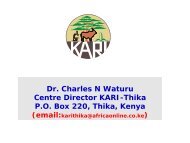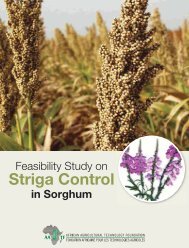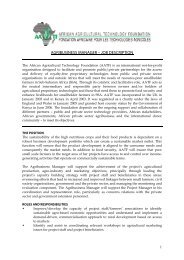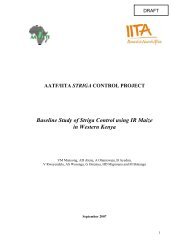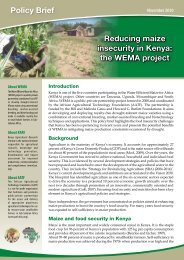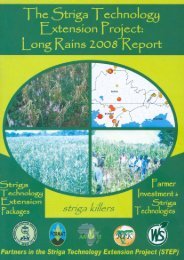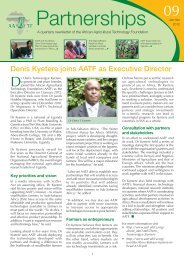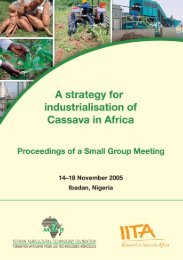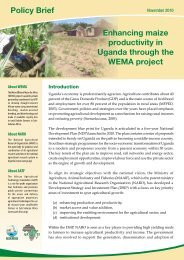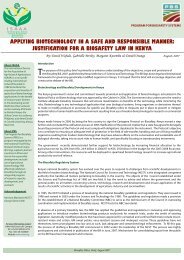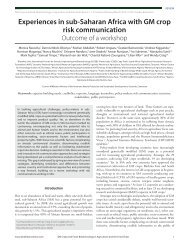AATF Inaugural Report - African Agricultural Technology Foundation
AATF Inaugural Report - African Agricultural Technology Foundation
AATF Inaugural Report - African Agricultural Technology Foundation
You also want an ePaper? Increase the reach of your titles
YUMPU automatically turns print PDFs into web optimized ePapers that Google loves.
A New Bridge to Sustainable <strong>Agricultural</strong> Development in Africa<br />
its most economically valuable part, have poor<br />
keeping qualities and must be processed within<br />
three days.<br />
However, inefficient traditional <strong>African</strong><br />
production practices and processing methods<br />
lead to comparatively high production costs and<br />
to cassava products that are of generally low<br />
quality. This limits the ability of <strong>African</strong> cassava<br />
products to enter local industrial markets or to<br />
compete with maize in global starch markets.<br />
Measures that will reduce the production costs<br />
of <strong>African</strong> cassava producers will help reduce<br />
poverty by making cassava farming more<br />
profitable while lowering the price of cassava to<br />
consumers.<br />
A technology needs assessment for improving<br />
cassava productivity was conducted during the<br />
2004 symposium of the International Society for<br />
Tropical Root Crops – Africa Branch (ISTRC-<br />
AB) to identify technological interventions that<br />
could increase cassava productivity in Africa.<br />
The results suggest that farm mechanization<br />
would make the greatest contribution to increasing<br />
cassava productivity. However, cassava farming<br />
and processing machinery producers from<br />
outside Africa are reluctant to sell equipment to<br />
<strong>African</strong> countries for fear that such equipment<br />
will be copied by local engineers, pointing to an<br />
IP issue that needs to be resolved.<br />
The overall goal of this project will be to<br />
improve cassava productivity through appropriate<br />
mechanisation aimed at optimising labour<br />
productivity during production and processing<br />
operations and opening up new market opportunities<br />
for cassava products.<br />
<strong>AATF</strong>’s role in this project is to clarify<br />
and seek to resolve key IP issues involved in<br />
the acquisition and deployment of proprietary<br />
machinery for cassava production and processing.<br />
Working with its partners, the <strong>Foundation</strong><br />
will help organize a meeting of experts in 2005<br />
to develop a master plan for the industrialisation<br />
of cassava in Africa. This plan will be designed<br />
to facilitate the efforts of all stakeholders along<br />
the cassava value chain to promote cassava-based<br />
industries in Africa.<br />
Partner Institutions<br />
• <strong>African</strong> <strong>Agricultural</strong> <strong>Technology</strong> <strong>Foundation</strong><br />
(<strong>AATF</strong>)<br />
• International Institute of Tropical<br />
Agriculture (IITA)<br />
• United Nations Industrial Development<br />
Organization (UNIDO)<br />
Discontinued Projects<br />
Pro-Vitamin A Enhancement in Maize<br />
Malnutrition is common in sub-Saharan Africa.<br />
About 40–50% of the region’s population remains<br />
malnourished each year and the region is worse<br />
off nutritionally today than it was 30 years ago.<br />
Many of the hungry and malnourished are the<br />
more vulnerable members of society – women<br />
and children. The most widespread micronutrient<br />
deficiencies in Africa are those of iron, zinc and<br />
vitamin A. In children, malnutrition often leads to<br />
diminished cognitive development and suboptimal<br />
functioning of their immune systems. In communities<br />
where vitamin A deficiency is endemic,<br />
improving availability of the vitamin can reduce<br />
child mortality by over 20% and mortality due to<br />
measles by as much as 50%.<br />
Building the required micronutrients into<br />
food through biofortification is both sustainable<br />
and cost effective. In this instance, a combination<br />
38



